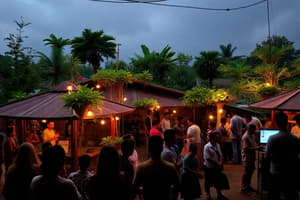Podcast
Questions and Answers
What is the difference between environmental determinism and possibilism?
What is the difference between environmental determinism and possibilism?
Environmental determinism is the belief that the physical environment exclusively shapes humans, their actions, and their thoughts. Possibilism is the viewpoint that people, not environments, are the dynamic forces of cultural development.
Which of the above concepts do geographers buy into the most?
Which of the above concepts do geographers buy into the most?
Possibilism.
What types of things are you likely to see on the cultural landscape compared with a physical landscape?
What types of things are you likely to see on the cultural landscape compared with a physical landscape?
A cultural landscape shows human impact, including religious structures, agriculture, houses, roads, etc., while a physical landscape is unaltered by humans.
Name three cultural hearth regions of the world.
Name three cultural hearth regions of the world.
How is innovation different from diffusion?
How is innovation different from diffusion?
What is an independent innovation?
What is an independent innovation?
Explain the difference between Relocation Diffusion and Expansion Diffusion.
Explain the difference between Relocation Diffusion and Expansion Diffusion.
What are the three types of Expansion Diffusion?
What are the three types of Expansion Diffusion?
What is syncretism and how could McDonald's be used as an example?
What is syncretism and how could McDonald's be used as an example?
What is an example of a diffusion barrier?
What is an example of a diffusion barrier?
What is cultural lag?
What is cultural lag?
What is globalization?
What is globalization?
What type of diffusion is the sharing of medical discoveries first to the medical community through scholarly journals?
What type of diffusion is the sharing of medical discoveries first to the medical community through scholarly journals?
What do we call the phenomenon where the further away from the hearth region, the longer it will take for an item of culture to diffuse?
What do we call the phenomenon where the further away from the hearth region, the longer it will take for an item of culture to diffuse?
What is an example of space-time compression?
What is an example of space-time compression?
Consider the cultural subsystems (Ideological, Technological, and Sociological). Explain artifacts, mentifacts, and sociofacts, and to which cultural subsystem each belongs.
Consider the cultural subsystems (Ideological, Technological, and Sociological). Explain artifacts, mentifacts, and sociofacts, and to which cultural subsystem each belongs.
Is a firefighter's uniform an example of a sociofact, artifact, or mentifact? Explain.
Is a firefighter's uniform an example of a sociofact, artifact, or mentifact? Explain.
Flashcards are hidden until you start studying
Study Notes
Environmental Determinism vs. Possibilism
- Environmental determinism posits that the physical environment shapes human behavior and culture.
- Possibilism argues that humans are the main agents of cultural change, with environments serving as potential influences.
- Both concepts are part of Cultural Ecology.
Geographers' Preference
- Geographers predominantly support possibilism over environmental determinism, viewing the latter as overly restrictive.
Cultural vs. Physical Landscape
- A cultural landscape reflects human impact and can include structures such as religious buildings, roads, and farms.
- A physical landscape is characterized as unaltered by human activity.
Cultural Hearth Regions
- Key cultural hearth regions include Meso-America, Andean region, West Africa, Crete, Egypt, Mesopotamia, Indus Valley, North China, and Southeast Asia.
Innovation vs. Diffusion
- Innovation refers to the creation of new ideas within a culture.
- Diffusion involves the adoption of innovations from an external source.
Independent Innovation
- Independent innovation occurs when similar new ideas develop simultaneously in different locations without diffusion.
- Examples include the pyramids of Egypt and the Mayans, as well as the invention of the telephone.
Relocation vs. Expansion Diffusion
- Relocation diffusion involves the movement of culture due to relocation of individuals or groups, with geographic areas in between remaining unaffected.
- Expansion diffusion spreads cultural items progressively from the hearth, affecting all adjacent regions.
Types of Expansion Diffusion
- The three types of expansion diffusion are:
- Contagious Diffusion
- Hierarchical Diffusion
- Stimulus Diffusion
Syncretism and McDonald's
- Syncretism occurs when two cultural elements combine to form new practices.
- McDonald's adapts its menu and structure to align with local cultures, exemplifying syncretism.
Diffusion Barriers
- Cultural practices may resist adopting goods or ideas due to religious restrictions, creating diffusion barriers.
Cultural Lag
- Cultural lag refers to a social group's inability to adapt to changing circumstances or innovations.
Globalization
- Globalization describes the growing interconnectivity among the world's regions and cultures.
Hierarchical Diffusion
- Medical discoveries disseminated first to specialized communities, such as via scholarly journals, exemplify hierarchical diffusion.
Distance Decay
- The concept that cultural items take longer to diffuse as the distance from the hearth increases is known as distance decay.
Space-Time Compression
- Advances in travel allow rapid movement across distances, reducing travel time significantly.
Cultural Subsystems
- Mentifacts encompass belief systems, values, and ethics, belonging to the Ideological Subsystem.
- Artifacts are tangible materials fulfilling basic needs and belong to the Technological Subsystem.
- Sociofacts represent social organization and relationships within a culture, part of the Sociological Subsystem.
Firefighter's Uniform Classification
- A firefighter's uniform serves a practical purpose and is thus classified as an artifact.
Studying That Suits You
Use AI to generate personalized quizzes and flashcards to suit your learning preferences.





